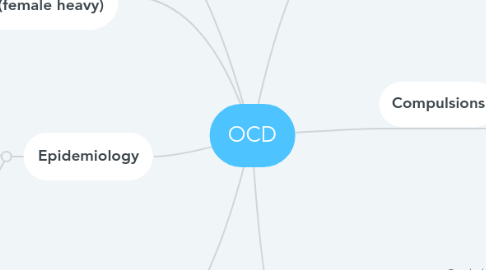OCD
by Sydney Rudd


1. Prevalence similar in males & females - unlike most anxiety disorders (female heavy)
2. NOT delusion - individual has insight & awareness of disorder NOT psychotic - no loss of contact with reality
3. Epidemiology
3.1. 1% prevalence - young adults & teenagers
3.2. Chronic - lifelong
4. Further reading
4.1. Stein (2002)
4.1.1. OCD = example of neuropsychiatric disorder moderated by neuronal pathways
4.1.2. Responsive to drug & therapy treatment
4.1.3. Once viewed as rare // one of the most prevalent psychiatric disorders
4.1.4. Obsessions increase anxiety Compulsions reduce anxiety
5. Obsessions
5.1. Cause anxiety
5.2. Intrusive, negative & unpleasant thoughts, image, fears or impulses
5.3. Greatest fear is acting upon obsession
5.4. Individual recognises that they're irrational & try to resist
6. Compulsions
6.1. Behaviours / acts to reduce anxiety caused by obsessions - usually avoidance
6.2. Quasi rituals - performed unwillingly, e.g. safe numbers, whereby an individual repeats a behaviour a certain number of times to reduce anxiety
6.3. Broken ritual = start again
6.4. May not be logically consistent, e.g. compulsive hand washing // don't shower
7. Treatments
7.1. Psychological therapy
7.1.1. CBT
7.1.1.1. Cognitive = obsessions
7.1.1.2. Behavioural = compulsions
7.2. Drugs
7.2.1. SSRIs, most common, e.g. Prozac / Fluoxetine
7.2.1.1. Reduce anxiety & emotional fluctuations
7.2.2. BZs, e.g. Diazepam / Valium
7.2.2.1. Powerful tranquilizer
7.2.3. Tricyclic antidepressants, e.g. Clomipramine
7.2.3.1. Work on serotonergic system (like SSRIs) // suicidal side effects

